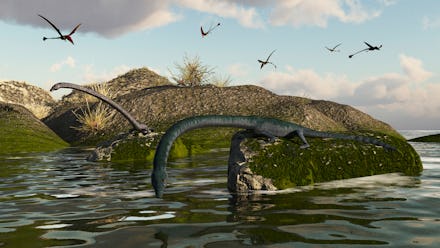This weird reptile with a 9-foot neck was "one of the most baffling animals that ever lived"

Prehistoric creatures are really, really weird. From 'hell ants' with vertical mandibles to 'terror crocodiles' with banana-sized teeth, these ancient, unusual creatures have for decades kept scientists busy trying to figure out how the hell they lived. One mysterious animal is the Tanystropheus, an enormous reptile approximately 20-feet-long with a ridiculous 9-foot-long neck that looks more cumbersome than useful.
Scientists have wondered for years why a creature would evolve to have such a long neck, but a study published last week in the journal Current Biology has shed some light on how the Tanystropheus might have used its absurd gullet.
To learn more about how the Tanystropheus lived its life, the research team, led by paleontologist Stephan Spiekman, made CT scans of their fossils and created 3D models of them. This was no easy task, as many of their remains were smashed and mixed up like a puzzle. The team had to virtually reassemble Tanystropheus piece-by-piece.
"The power of CT scanning allows us to see details that are otherwise impossible to observe in fossils," Spiekman said in a press release. "From a strongly crushed skull we have been able to reconstruct an almost complete 3D skull, revealing crucial morphological details."
Those details included the location of Tanystropheus's nostrils on the top of its snout and the shape of its teeth — both hinting that the creature was a water-dwelling nightmare. It is “one of the most baffling animals that ever lived,” Spiekman told the New York Times.
"Tanystropheus looked like a stubby crocodile with a very, very long neck," said co-author and paleontologist Olivier Rieppel in the release. This actually made more sense to the scientists, who believe the neck would've been less bothersome to manage in the water than on land.
"That neck doesn't make sense in a terrestrial environment," Rieppel added. "It's just an awkward structure to carry around."
Based on its anatomy, the team hypothesized that Tanystropheus stayed in the murky shallows to snap up fish and squids floating by. Its stubby body didn't appear well-suited for swimming in deeper waters.
"Even the most ocean-going crocodile today, the saltwater croc, generally stays close to the shore," Spiekman explained to SYFY Wire. "I would argue that the same case can be made for Tanystropheus. The long neck probably evolved after it started living at least partially in the water, and once this neck was so long, it didn't need to evolve flippers because it could already feed, breed, and stay out of trouble successfully enough."
The paleontologists made an additional fascinating discovery — that there were miniature versions of the Tanystropheus. This dwarf species was initially thought to be juveniles of the bigger types because of their similar anatomy, but CT scans revealed different teeth and mature bones. The smaller Tanystropheus had teeth that were better shaped for munching on softer water-dwellers, like shrimp, and necks that still helped them lunge for prey without moving much in the water. Both the large and small species managed to live and feed in the same area without competing against each other because they hunted different creatures.
It's an important distinction to make that can help scientists better understand how the Tanystropheus family evolved and branched off.
"The power of CT scanning allows us to see details that are otherwise impossible to observe in fossils," said Spiekman. "This is really remarkable, because we expected the bizarre neck of Tanystropheus to be specialized for a single task, like the neck of a giraffe. But actually, it allowed for several lifestyles. This completely changes the way we look at this animal."